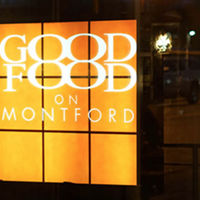Tuesday, July 12, 2011
News New exhibit at the Harvey B. Gantt Center — Live and In Stereo(type) — sparks debate, inspires July 21 artists roundtable
Posted By Carlton Hargro on Tue, Jul 12, 2011 at 9:31 AM
It would be a stretch to call Live and In Stereo(type) — the recently opened exhibition by artists Marcia Jones and Fahamu Pecou on display at the Harvey B. Gantt Center for African-American Arts + Culture — obscene or offensive. After all, the show (which features works that are “social critiques on black masculinity and imposed feminine ideals”) doesn’t include any art along the lines of, say, Chris Ofili’s feces-flavored “The Holy Virgin Mary.”
But, while Live isn’t some bizarre circus of perversion, it is provocative — and it does have folks (some Gantt staff and visitors) talking. Unfortunately, much of the “talking” has taken the form of visceral reactions based on uninformed interpretations of the exhibit.
“Part of the reason there’s been the reaction — and I’m talking about Marcia’s and Fahamu’s work — is because there’s not been a clear understanding of the historical references, art history references, African-American and African history references and pop culture references [in the show],” said Ce Scott, creative director for the Gantt and for McColl Center For Visual Art, and the curator of Live and In Stereo(type). “There’s also, in my mind — and I think this is, quite frankly, just an American thing — people don’t understand satire.”
“When I spoke to the person who deals with guest services and visitors [Marcia Rhodes at the Gantt],” Scott continued, “one of things she said to me was ... people coming from outside of the country love it, they get it, not offended at all. People, for the most part, that are coming from outside of Charlotte love it, get it. People that are within the area — and it might be an old guard, I don’t know who these people are because I have not met them — they’re offended, they think it’s sacrilegious, demeaning, demeaning to women and to African-Americans, it could put the Center in a bad light ... this whole host of things.”
So what exactly is being depicted in the art of exhibit? Well, Pecou has created a collection of stark, sparse paintings that cast him as the main image and make use of “familiar references to raise questions about the stereotypes that fuel fame, drive consumerism and perpetuate celebrity worship.”
And Jones has crafted a body of bold, colorful pieces (from her series The Displaced Oshun Theory) that utilize a number of divergent media and textures to “examine the purposeful patriarchal division of The Divine Mother (Mary the Virgin) and The Sacred Whore (Mary Magdalene)”; illustrating that examination, two pieces from the series feature images of what appear to be strippers surrounded by dollar bills adorned with the likeness of Michelle Obama — in place of a dead president.
“What I was trying to do [with the pieces featuring Michelle Obama] was say, ‘What if I juxtapose these two things: a stripper ... with the money at her feet and it has Michelle Obama’s face on it?’ You’re comfortable with all the presidents’ faces on it, but what if it’s Michelle Obama money? Now what? We put the Divine Mother at her feet in value. Do we not value this girl on this pole?” said Jones. “I’m ... layering that with African mythology and spirituality and introducing the Pantheon of Orishas where there is no division. There is no one or the other. Everyone is their own entity in their own right, but as a collective, they are the women of the Pantheon. And so, they give a space for whomever you are to exist whole as a group. Here ... it’s like you’re a good girl or you’re a bad girl. Or, if you’re a good girl, it’s like, be a bad girl behind closed [doors].”
“This is work that is ... edgy and addresses some issues that either have not been talked about or understood or also maybe targets some public figures or religious icons that are near and dear to people,” Scott said, “and because they are so near and dear to people they feel like anytime something is said about them or portrayed about them ... if any way they feel like it can be perceived as derogatory, then there’s an issue.”
To combat some of the confusion surrounding the exhibit, Scott, Jones, Pecou and Gantt Center staff are moving forward with two initiatives. First, more detailed information has been written to accompany and further explain works in the exhibit. Second, the Center is playing host to a dialogue on July 21 at 6:30 p.m., which will give anyone who’s interested in the show the opportunity to speak directly to the people responsible for the art. Pecou and Jones hope these efforts can help educate concerned parties about the real meanings behind their work.
“What’s going on right now, to my understanding, is people are uninformed about my methods, about what it is I’m trying to say; about how I am juxtaposing these images and why I’m juxtaposing these images,” said Jones. “It’s like I’m saying things that don’t match to them. But they match to me, and I want to try to explain how they match and where the idea was derived from. What made me sit there and say, ‘Oh my God, I’m gonna juxtapose all this because it all kind of looks the same to me?’ I’m not trying to change anybody’s mind about it, but I’m trying to put another perspective on it maybe.”
“I hope that it’s actually a conversation and not a witch hunt,” Pecou said regarding the upcoming roundtable. “I’m looking forward to really having a good dialogue and hopefully having people walking away and feeling like, ‘OK, I got something out of that.’ Not feeling like: ‘I’m just here to shut this shit down.’ This ain’t the Tea Party.”
For more information about Live and In Stereo(type) and about the artists talk on July 21, visit www.ganttcenter.org.
Speaking of...
Latest in The CLog
More by Carlton Hargro
-

The secret origin of rising comic star Jason Latour
May 21, 2014 -

Interview: Chatting with The Foreign Exchange
Aug 30, 2011 -

Phife of A Tribe Called Quest hits the Q.C. Aug. 31
Aug 30, 2011 - More »











